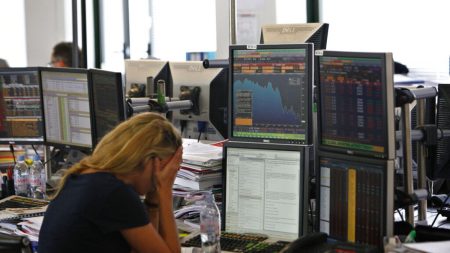Paragraph 1: European Markets Surge on Cooling Inflation
European stock markets enjoyed a robust rally on Wednesday, propelled by encouraging inflation data from both the UK and the US. The Euro Stoxx 600 index, a broad gauge of European equities, surged 1.33%, marking its most significant single-day gain in nearly five months and snapping a three-day losing streak. This positive momentum was echoed across major European indices, with Germany’s DAX reaching a record high with a 1.5% increase, outperforming global averages with a year-to-date gain of 3.34%. The FTSE 100 in the UK also saw a substantial 1.21% rise, recovering some ground lost during the recent British bond market turbulence. France’s CAC 40, however, lagged behind its peers with a more modest 0.69% increase. This broad market rally was primarily driven by a "risk-on" sentiment among investors, fueled by the prospect of continued interest rate cuts by central banks in response to easing inflationary pressures.
Paragraph 2: Inflation Shows Signs of Retreating on Both Sides of the Atlantic
The positive market sentiment was underpinned by data indicating a cooling trend in inflation in both the US and the UK. US core inflation, which excludes volatile food and energy prices, dipped to 3.2% year-on-year in December, down from 3.3% in November. While headline inflation remained slightly elevated, this decrease, coupled with earlier cooler-than-expected producer price index (PPI) data, reinforced expectations of continued Federal Reserve rate cuts in 2025. In the UK, December’s inflation figures also offered a respite. Headline inflation registered at 2.5%, while core consumer prices came in at 3.2%, both below market expectations. This marked the first decline in UK inflation in three months and provided a welcome sign of easing price pressures. These combined factors significantly contributed to the optimistic mood in the markets.
Paragraph 3: Market Expectations and Central Bank Policy
The inflation data played a crucial role in shaping market sentiment and expectations regarding future central bank policy. Prior to the releases, there were apprehensions that persistent inflation and resilient labor markets might force the Federal Reserve to halt its rate-cutting cycle. While a pause at the upcoming Fed meeting is widely anticipated, the latest data have strengthened the case for further rate reductions later in 2025. Similarly, the cooling inflation in the UK bolstered expectations that the Bank of England would continue its easing cycle, offering some reassurance after the recent market volatility. In the eurozone, the final inflation data for December is due on Friday, with preliminary figures already pointing towards a potential 25 basis point rate cut by the European Central Bank in January.
Paragraph 4: Currency Markets and Lingering Uncertainties
Despite the positive stock market performance, the euro and the pound sterling faced challenges. The euro pared back some of its earlier gains against the US dollar, weakening slightly to 1.0288. Similarly, the pound, after briefly reaching a one-week high, retreated against both the dollar and the euro. This currency weakness reflects ongoing economic and political uncertainties, particularly in the UK. Despite the encouraging inflation data, concerns persist about the UK’s fiscal situation and the limited fiscal maneuvering room available to the Chancellor, which contribute to a higher risk premium being priced into UK assets.
Paragraph 5: Wall Street Joins the Rally, Fueled by Strong Bank Earnings
The positive sentiment extended across the Atlantic, with Wall Street experiencing a significant rally, especially in the technology sector. Adding to the bullish momentum were strong earnings reports from major US banks, including JP Morgan Chase, Citigroup, Wells Fargo, and Goldman Sachs. These positive financial results further reinforced the optimistic outlook among investors, contributing to the broad market gains.
Paragraph 6: Outlook and Potential Headwinds
While the cooling inflation data has provided a welcome boost to markets, the outlook remains subject to potential headwinds. The economic and political landscapes in both Europe and the UK remain complex, and concerns linger about the potential for future disruptions. While the easing of inflationary pressures supports the case for continued central bank easing, the path forward remains uncertain, and market volatility could persist in the face of evolving economic data and geopolitical developments. The divergence in monetary policy between the Federal Reserve and the European Central Bank is also expected to continue to exert pressure on the euro against the dollar. While the recent market rally is encouraging, investors remain cautious about the long-term outlook, with ongoing uncertainties prompting a degree of guarded optimism.














